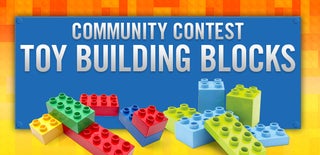Introduction: Custom Lego Table
Finding the perfect Lego storage/play area is not easy. I could not find anything that fit my needs so I created my own Lego table for both creativity and containment.
Step 1: Find Solid Wood Table or Coffee Table
This table is going to get a lot of abuse from small children so you want it to be very sturdy. If you start with a standard height table cut the legs to the height you want. We wanted our table to sit 18 inches high. It’s a great height for small kids to stand, older kids to kneel and adults to sit and play at. You can use a coffee table and save yourselves a step
Step 2: Supplies You Will Need:
Table
Lego base-plates
¾ inch MDF or plywood
Table Saw
Measuring tape
Jig saw
Painters tape
Wood glue (Titebond III)
Nails
Bar Clamps
Angle brackets
Router
1/2" D x 1-1/2" H x 1/2" Shank Piloted Flush Trim Bit
Shank Rounding Over Bit
Wood putty
Sandpaper/palm sander
Paint/paintbrush
Liquid Nails
Step 3: Determine You Dimensions
I decided I wanted to put 5x10 inch Lego base-plates around the Lego table, with three on each side. I decided where I wanted them and then we used painters tape to map out visually where I wanted the Lego storage box to go. Our table was 70 inches by 30 inches so we decided the inside of the box should be 16 x 44 inches.
Step 4: Build Box
We used ¾ inch MDF to construct the Lego storagebox (you could use plywood, but we had MDF on hand). Make sure to account for the table top thickness when determining the size to cut the box side pieces. Cut the box sides and bottom of the box on a table saw to make sure they all have square edges. Then use a few nails, glue and bar clamps to build the box. We used Titebond III white glue, but any good quality wood glue would do. You want to make sure the box is built very strong because there is a good chance there will be a child standing in it at some point in the table’s life (has already happened many times with my boys).
Step 5: Cut Hole in Table
When the box was finished and the glue is completely dried use a jig saw to cut an opening 1 inch smaller than the inside of the box in the center of the table.
Step 6: Attach Box to Table
Turn the table over and glue the box onto the bottom of the table so that there is approx. ½ overhang of the table into the box on all sides. Clamping the box onto the bottom of the table for gluing took a combination of clamps and 2x4s. Again thinking of kids sitting or standing in the table we took our time to make sure we had strong glue joint. As a safe guard we also installed an angle bracket with wood screws on each side of the box.
Step 7: Router
Once the glue was dried we turned the table over and using a router and a 1/2" D x 1-1/2" H x 1/2" Shank Piloted Flush Trim Bit, We found you could easily trim the overhang of the table to be exactly even with the inside of the box. Once the table top was trimmed we used a Shank Rounding Over Bit to round the inside edge of the table top.
Step 8: Sand/Putty
Now that the table is built its time to finish it. I used a palm sander to sand the whole table and remove all the remaining shine so paint would stick. The area all-round the cutout for the Lego storage box will need a fair amount of putty. Putty it well and sand it well and it will look seamless when painted.
Step 9: Paint
Paint the whole table! I like to use an angled brush and make sure to paint with the wood grain. To get a smooth finish I use 400 grit sandpaper and lightly sand between each coat. If you use a flat to satin finish you can also sand after your last coat. I feel like this step makes all the difference in the final product. I have found that if you use a semi-gloss or gloss you do not want to sand after the last coat because it ruin the sheen. After you sand wipe down with a damp cloth to remove all the dust.
Step 10: Polyacrylic
To protect the paint you can finish by coating with Polyacrylic (spray or paint on). This is very important because kids and Legos can be very rough on a paint job. Polyacrylic is a better product to use then varnish on painted projects because it will not yellow over time.
Step 11: Apply Base-plates
Use liquid nails to attach the base-plates to the table. Make sure you put a lot on but do not let it flow out from under the base-plate. If you are using more than one base-plate next to each other you do not want to butt them up directly next to each other because Lego’s will not fit between them. Take a Lego and attach it to the top of the two base-plates so they will be the correct distance from each other. We put some weight on top of the applied base-plate and let it sit overnight.
Step 12: Enjoy
Fill the Lego storage box with Legos and enjoy. This table has entertained my children for more hours than I can count since we made it.

First Prize in the
Community Contest: Toy Building Blocks











